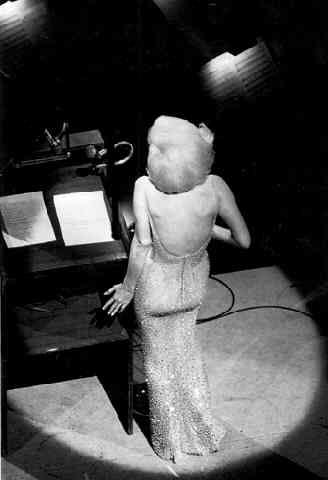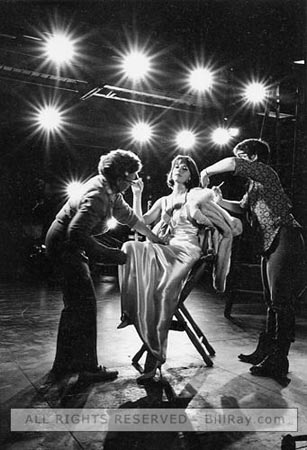Those were the days: Bill Ray's photos capture the spirit of an age
November 28, 2014 | Source: Monroe Gallery of Photography
Via Pasatiempo
The Santa Fe New Mixican's Weekly Magazine of Arts, Entertainment, & Culture
by Paul Weideman

Bill Ray: Marilyn Monroe singing "Happy Birthday" to President John F. Kennedy, May, 1962
Ray was born in Shelby, Nebraska, in 1936, a few months before the first copy of Life magazine hit the stands. He started as a staff photographer at the Lincoln Journal Star the day after graduating from high school. At seventeen, he photographed President Dwight Eisenhower and Vice President Richard Nixon, who were visiting Nebraska. During that time, he had the opportunity to meet Gen. Curtis LeMay. It was a foreshadowing of a career full of celebrity encounters.
He went on to work for United Press International in Chicago and for the Minneapolis Star and Tribune.Then, in 1957, he turned down a job with National Geographic to begin freelancing for Life. He was soon a staffer working out of the magazine's New York, Beverly Hills, and Paris bureaus. In his 2007 photo-filled biography, My Life in Photography, Ray says it could also have been titled "My Life With Marlys," after the woman he met in 1956 and married in 1958. She has been an invaluable assistant — and his agent, ever since Life folded in 1972.
The many subjects in Ray's portfolio include a newly enlisted Elvis Presley about to board a troopship bound for Germany; John and Jackie Kennedy in the early 1960s, and Jackie and Aristotle Onassis later that decade; a stunning close-up of actress Natalie Wood; a fierce Muhammad Ali in the ring; George Harrison and Bob Dylan singing at the Concert for Bangladesh; baseball star Roger Maris at bat; Roman Polanski and Sharon Tate strolling along a London street; a series on Ronald Reagan and his family; and candids of artist Isamu Noguchi and cartoonist Charles M. Schulz. Ray also did two Army tours as a photographer in Vietnam.
After Life ceased publication, he freelanced for Newsweek, Archaeology, Smithsonian, and Fortune, and developed a portrait specialty. "One thing I'm still good at is people," said Ray, whose recent work includes an official portrait of "a retiring big-time minister at St. Bart's here in New York. His predecessors had all been painted in oil, and he wanted a photograph instead."
Pasatiempo: Early on, your mother supported your desire to be a photographer, isn't that right?
Bill Ray: She did. She was quite a character. Both my parents were just perfect. I had a terrific childhood. My mom was very busy with her art and loved the idea of my pursuing something like that. We were not by any means wealthy, but she always found money if I needed a camera.
Pasa: Your main role model was Alfred Eisenstaedt. Why him?
Ray: It was just from reading Life magazine and having a passion about photography. I loved growing up as a kid in a tiny little town, but as I got older it was clear that I wanted to get the hell out of there. My dad would have given me the lumberyard he owned, but I didn't want to sell two-by-fours. I had a passion about going to New York and Life magazine. Fred Astaire was from Omaha, and when I saw him dance [in a movie] with Cyd Charisse in Central Park, that was it: I'm going.
Pasa: A lot of what you did were sort of Johnny-on-the-spot news assignments covering things like a Muhammad Ali fight or Nikita Khrushchev visiting a farm in Iowa.
Ray: That's right, but I also originated a few ideas. For example, in 1959, there was a little story in the paper — every morning when I got up, I'd grab The New York Times,The Wall Street Journal, the Daily News, the [Daily] Mirror, and whatever else I could get my hands on — and there was a little story about a bunch of people in Detroit who were going to Alaska to homestead. I rushed over and showed the picture editor the story, and he said, "Go ahead, go." I was very enthusiastic and worked very hard on every assignment. You have to be intense and keep going. That's the only way to keep the assignments coming.
Pasa: It was pretty competitive?
Ray: Oh, god, at Life magazine, yeah. Everybody in the world wanted to work there.
Pasa: You used many different kinds of cameras. To shoot Andy Warhol, you had a giant Polaroid camera, and on the other end of the spectrum there's a picture in the book of you at age eleven, concentrating on the viewfinder of a Speed Graphic.
Ray: That's when I belonged to the Omaha Camera Club. The tiny village I grew up in was 90 miles away, so we'd go into Omaha once a week. It's there that I met my mentor, who was a brilliant commercial photographer. He really got me on the right road to how photography technically works. The Speed Graphic was the basic tool at the newspaper I started working at when I turned seventeen in May 1953. I had a Leica and a Rolleiflex and a Linhof, but you really had to use the 4 x 5 [medium-format camera] to make the deadlines.
Pasa: I would think the bigger camera with the film holders was slower than a 35-millimeter camera.
Ray: But for most assignments, you shoot just one or two holders [two shots in each holder], and you come rushing in and soup [develop] that, and you can print a 4 x 5 negative wet.
Pasa: I read that Marlys always traveled with you and loaded the cameras.
Ray: Yeah, and she was the fastest there was at loading a Hasselblad, and she always kept the film straight. You have to know which roll is which, because I would say, "We're going to push this roll a half [in development time to increase contrast]," or whatever. Under pressure, you have the president or Moshe Dayan and only a limited amount of time, so you really shoot like hell. We traveled a lot. We spent months in Japan, and we traveled for about 10 months with Carl Sagan around the world.
Pasa: Sid Monroe at the gallery told me that Life never ran the photos you took of the Hells Angels.


Bill Ray: Hells Angels, Los Angeles, 1965
Ray: The story was killed by the managing editor. I heard that he said, "I don't want these smelly bastards in my magazine." And that was after I worked on it a month. The thing about the Hells Angels is that they are now very popular. Marlys and I found those negatives and got them online, and the emails from all over the world are astounding.
Pasa: Your abilities show up in composition, people's expressions and body language, and lighting — and most of what you did for Life was shot in ambient light.
Ray: That's right, although I did almost 50 covers for Newsweek, for example, of Luciano Pavarotti and Itzhak Perlman, and those were all strobe. Another thing about the technique is that in those days — it seems so long ago now — you had to focus and you had to have the right exposure. Even though this digital revolution is truly a revolution — it's just so huge it's hard to comprehend — the basics, lighting and composition, are so important.

Natalie Wood on the set of "Sex and the single girl", with hairdressers, 1963

Natalie Wood on the set of "Sex and the single girl", with hairdressers, 1963
One of the places I learned composition was going to museums and looking at paintings. You kind of develop an instinct about the composition. But you have to be really fast. That's the fun part. â—€

